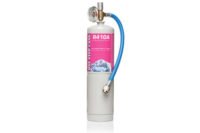When I was younger, I owned a 1973 Oldsmobile Cutlass Supreme. It was a beautiful car: deep red with a black vinyl roof (remember those?) and a black vinyl interior that was alternately skin-searingly hot in the summer and as cold as ice in the winter. The “Rocket 350” engine with its 4-barrel carburetor always ran great — and probably delivered somewhere between 10-12 miles per gallon (I never calculated it).
I remember the car’s air conditioning breaking down one summer, and with that black top and those black seats, a/c was a necessity in the car. So, being reasonably young and dumb, I went up to the local K-Mart and bought a can of Freon to recharge the system.
I’m probably lucky I didn’t injure myself. I had no idea how an air conditioning system worked. I’m not even sure I hooked the refrigerant can up to the correct port. I remember the a/c compressor was running. Then, as I charged it, the compressor started chugging and smelled like it was burning. I quickly disconnected everything and took it in for a professional repair. The friendly folks at the auto repair shop educated me and said a/c systems are closed systems. If a system isn’t working because it’s low on refrigerant charge, it’s because it’s leaking. My self-repair, if it had worked at all, would only have lasted until the new refrigerant had leaked out.
At times since then, I have marveled at how different the world was back then, when a 20-something knucklehead could just buy refrigerant and basically pump it into the atmosphere.
That’s why I was so stunned to see a commercial on TV the other day for A/C PRO, a do-it-yourself a/c recharge kit for cars and trucks. I went to the website (acprocold.com) and, sure enough, they’re selling recharging canisters of R-134a for do-it-yourselfers. To their credit, their website offers some educational pointers, including a port finder feature so people will at least hook the can up to the low-pressure port. They also offer leak sealers, a hose and a gauge kit. (My 1980s-era recharge attempt was done without the benefit of a gauge!)
Maybe this new recharge kit is fine. Maybe it’s way better than what I used in the 1980s. Maybe the available leak sealer product will seal some system leaks and prevent what would otherwise be basically immediate emissions of R-134a into the atmosphere as the leaking system accepted the new charge and then started leaking it out. But that’s a lot of maybes.
Our industry is under constant fire to reduce emissions of HFCs. In a recent conversation, Kevin Fay, executive director of the Alliance for Responsible Atmospheric Policy, noted that most emissions of HFCs in the refrigeration industry come from leaks, and during servicing and disposal of equipment. Fay said that improved service practices will be an important part of the HFC management discussion going forward.
Our industry is already investing — and in the future will continue to invest — a tremendous amount of money and resources into training to ensure better control of HFC emissions.
Meanwhile, people who know nothing about how an air conditioning system works can buy R-134a from a website and attempt to charge their car’s air conditioners. We’ve all learned a lot since the 1980s. Haven’t we?











